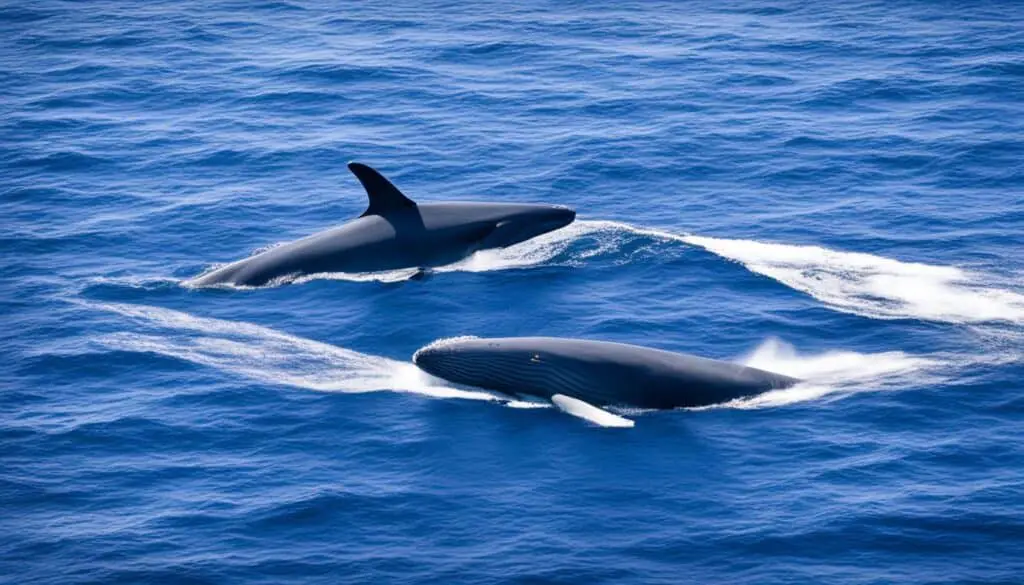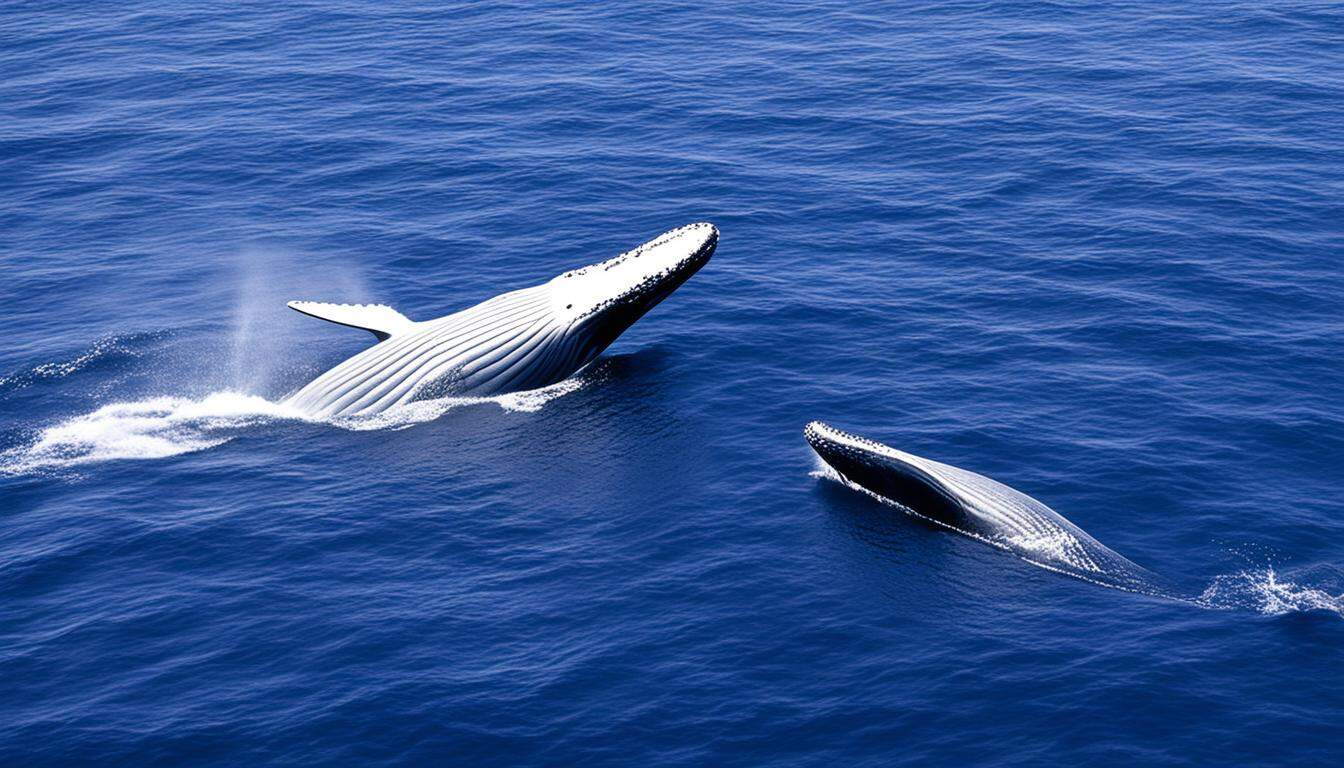Learning about blue whale reproduction helps us understand these amazing creatures better. These are the biggest animals on our planet. They become ready to have babies between 5 to 15 years old. Once ready, they can have a calf every 2 to 3 years.
This process is key to their survival. It’s important to know how they reproduce because they face many dangers. These dangers include past whaling and today’s environmental issues.
Understanding Blue Whale Reproduction
To understand blue whale reproduction, we must look at the key parts of their breeding process. This species has specific behaviors during their reproductive cycle. These behaviors are vital for conservation efforts.
Overview of Blue Whale Breeding
Blue whales breed once they reach adulthood. They have clear roles for males and females in their reproductive system. Mating happens in warm waters during their migration, when conditions are best.
During mating, blue whales show unique courtship behaviors to form pair bonds. These actions and migrations are key to their reproductive success in different environments.
Significance of Mating Season
The timing of blue whale breeding is crucial for the survival of their young. Mating takes place in warm areas during their migration. This ensures a safe breeding environment.
Females use this time to build up energy for pregnancy and nursing. The mild conditions during this season boost the chances of successful births and nurturing. This makes the mating season vital for the species’ survival.
| Mating Factors | Details |
|---|---|
| Breeding Frequency | Once every 2-3 years |
| Optimal Breeding Temperature | 68°F – 78°F (20°C – 26°C) |
| Typical Calf Survival Rate | Over 70% in optimal conditions |
| Mating Duration | Several weeks during migration |
How do blue whales reproduce?
Blue whales have a unique way of reproducing that helps them thrive. They have special male and female parts and a unique way of making babies. Let’s dive into these details.
Male and Female Anatomical Differences
Blue whales have distinct parts that help them reproduce. Males have the biggest penises of any animal, reaching up to 10 feet long and 12 inches wide. These large penises are key for their reproduction.
On the other side, females have a long vulva and two mammary glands. These glands are crucial for feeding their young. This special setup is key to the success of blue whales in making more whales.
Internal Fertilization Process
The way blue whales fertilize inside is crucial for their survival. When males and females mate, the male’s sperm goes inside the female. This sperm meets the egg, creating a new life form.
This method gives the growing whale fetus the nutrients and protection it needs. It’s how blue whales keep their species going.
Blue Whale Mating Habits
Learning about blue whale mating habits helps us understand their reproductive strategies and behaviors. The courtship process is complex, influenced by the environment and individual whales.
Elaborate Courtship Rituals
Blue whales have fascinating courtship rituals to strengthen their bonds. These include:
- Vocalizations that echo through the ocean, drawing in mates.
- Synchronized swimming, where whales move together in perfect sync.
- Rolling and breaching, showing off their agility and strength.
These actions help build connections and prepare for mating. The courtship often ends with deep dives and surface displays, signaling readiness for mating.
Common Mating Locations
Blue whales go to warm waters near the equator to mate. These spots are ideal for whales and their calves during pregnancy and nursing. Key features of these areas are:
- Warm temperatures that make mating comfortable.
- Close to coastal areas with plenty of food, like krill, for nursing mothers.
- Less risk of predators, letting mothers focus on their calves.
Having lots of food in these areas is key. It helps mothers feed their young.

| Courtship Elements | Purpose |
|---|---|
| Vocalizations | Attracts mates and facilitates communication |
| Synchronized Swimming | Enhances bond and physical compatibility |
| Rolling | Displays agility and readiness |
| Deep Dives | Prepares for the mating process |
| Surface Displays | Signals readiness for copulation |
Blue Whale Gestation and Development
The reproductive cycle of blue whales is truly fascinating. It includes the challenges and milestones during the early life of the calves. The gestation period is about 12 months, resulting in a single calf. Most births happen between December and February in warmer waters, helping the newborns survive.
Gestation Period Details
At birth, blue whale calves are already quite big, measuring 23 feet long and weighing 5,000 to 6,000 pounds. This shows how important the gestation period is for their growth and health. The mother prepares a lot during pregnancy to make sure the calf is healthy when it’s born.
Calf Development Milestones
After birth, blue whale calves grow fast. They can gain 250 pounds each day, thanks to their mother’s high-fat milk. By six months, many calves double their length, reaching over 52 feet. These calf development milestones show how quickly they can grow and adapt in their huge environment.
Nursing and Care by Mothers
Nursing blue whale mothers are key to their calves’ early growth. Calves nurse for about six months, getting over 50 gallons of milk daily. This milk is very rich in fat, which is crucial for their growth and survival. Mothers also protect and care for their calves, making sure they are safe during this critical time.
Factors Affecting Blue Whale Reproductive Success
Understanding what affects blue whale reproduction is key for saving them. Many things, like the environment and human actions, play a big role. For example, ocean temperature changes can affect the food supply for pregnant whales. This can impact their health and the chances of their babies surviving.
Humans also pose a big threat to their reproduction. Accidents with ships and getting tangled in fishing gear can hurt adult whales. It also makes them stressed, which can mess up their mating and lower the number of babies they have. Plus, pollution can fill these whales with harmful substances, making it harder for their babies to survive.
We need to focus on these issues to help blue whales. By tackling climate change and protecting their homes, we can help increase their numbers. Good conservation plans are key to making sure these amazing whales keep living in their natural world for a long time.
FAQ
How do blue whales reproduce?
Blue whales reproduce sexually with distinct male and female roles. They reach sexual maturity between 5 to 15 years old. Mating happens in warmer waters, usually every 2 to 3 years.
What is the gestation period for blue whales?
The gestation period for blue whales is about 12 months. Births mainly occur between December and February in warmer waters. This ensures optimal conditions for calf survival.
What factors influence blue whale fertility?
Several factors affect blue whale reproductive success. These include environmental conditions, human activities, climate change, habitat loss, ship strikes, and ocean pollution.
How do blue whale mating habits affect calves?
Blue whale mating habits, especially the timing during migration, significantly impact calf survival. It allows mothers to gain energy for gestation and nursing in a favorable environment.
What are the anatomical differences between male and female blue whales?
Male blue whales have the largest penises in the animal kingdom. Females have a long vulva with two mammary glands. These are crucial for nursing their calves efficiently.
What is the breeding process of blue whales?
Blue whales undergo internal fertilization. Sperm is deposited inside the female during copulation. This leads to the formation of a diploid zygote that develops in the mother’s uterus.
What behaviors are involved in blue whale courtship?
Courtship rituals in blue whales include vocalizations, synchronized swimming, and rolling around each other. These behaviors help establish bonds and mating opportunities.
Where do blue whales typically mate?
Blue whales migrate to warmer waters near the equator for mating. They often go to coastal regions where krill is abundant. This provides necessary support for nursing mothers and their calves.
How do blue whale calves develop after birth?
Newborn blue whale calves are about 23 feet long and grow rapidly. By six months, they can reach over 52 feet in length. Their mother’s high-fat milk is essential for their early growth.
How long do blue whale mothers nurse their calves?
Blue whale mothers nurse their calves for about six months. They produce over 50 gallons of fat-rich milk daily. This supports rapid growth and development during this crucial phase.







